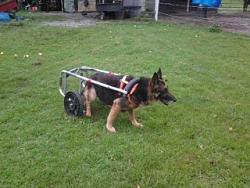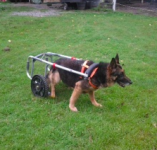I'm not sure this qualifies as a tool, but it sure makes the job of walking the dog and letting her do her duties much easier.
My sons 13 year old German Shepherd started losing the use of her back legs a few months ago. She has gotten so weak that she can't stand up or walk without help. He brought her over to the farm thinking she was ready to die and asked if I could help her, or put her down if not. One look at the dog and we all said, "this dog isn't ready to go." Eyes bright, alert, wanting to "do", just not able. Wife says, "can't you build her a wheelchair". Off to the shop, the shed and the internet.
I had a people walker that I was gonna use some of the aluminum for a tree stand. It was still complete. I weigh about 3 times the weight and it held my total weight and a lot of stress it wasn't designed for didn't affect it. This is the donor for the dog chair. Walmart sells a model(different design) for $439. If I screw up a $5.00 walker, I won't feel too bad.
I cut off the legs of the open side at the side support bars. Next I took the end stubs that pulled out of the bottom leg and put them into the remaining closed end leg bottoms(after removing the rubbers). After measuring the dog I decided a 10" gap would fit her. This was as narrow as the frame would let me cut and keep the lock bars. I cut out the center of the front top cross bar and cut the lower front cross bar in the center. Next, I bent the lower bar sections up to meet the top bar for strength and extra room for a tail. This is very thin wall tubing so forgive my welds. It is very strong and very light weight. I bolted brackets from hydraulic door returns that had wore out to the frame, drilled 5/8" holes in them and put grade 8 bolts in them(overkill). The wheels were off a garden cart that the axle rusted thru and all else was trashed. A piece of 3/4" conduit with neoprene cold water insulation bears the weight up front, but her rear legs still make the moves like walking.
This was the initial test drive. I put a shoulder harness under the frame and wound the shoulder loops over the rails. Picking the dogs back legs up and putting them through the loops was doable, but not fun. I set her down and off she went. Out in the yard, thru the grass, scared the hell out of the horses, back after doing her duty she goes in the shop to snoop around.
When she was done I decided the extra piece in the long rails put too much weight in front of her shoulders so it was removed and the shoulder bar put in the front of the adjustable bar. The rivets that hold the side cross support were drilled out of the top rails and 5/16" Briggs and Stratton head bolts from a grenaded opposing twin engine replaced the rivets with a little over an inch sticking above the top nuts. I took a piece of 4" load strap (left over from my flatbed days) and put gromets in it in each corner. 2 more B&S head bolts and it was done. You put the strap on one side, move the wheelchair over the dog. Lift up her belly and slide the strap under it and lift up and hook the strap on the other side. Then you try not to cry as she takes off like nothing was ever wrong.
Sorry I didn't get better, or final pictures. she went out to the gate and wanted to get in their SUV and go home. He says she is doing fine at the house and going for walks down the street.
The belly support has to be forward of the axles 3-5"s so the dog doesn't tip over backward.
Late entry..The shoulder bar is held on with 1/4" eye bolts with the loop on the bottom. Caribeener(?) clips hold the eye bolts to her halter so her front pulls the chair.


 LinkBack URL
LinkBack URL About LinkBacks
About LinkBacks



 Reply With Quote
Reply With Quote





Bookmarks